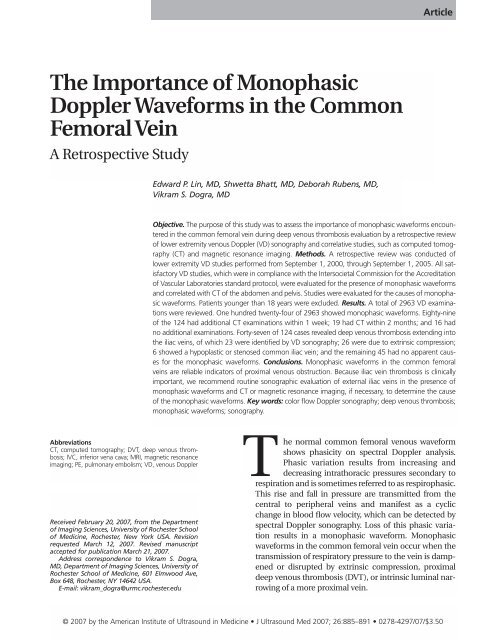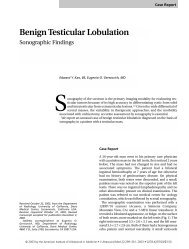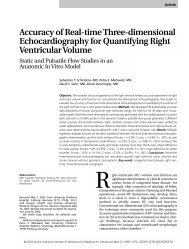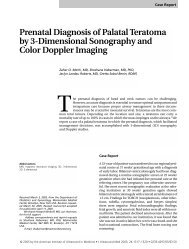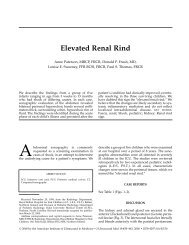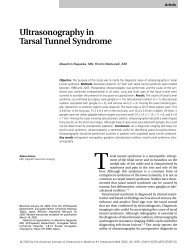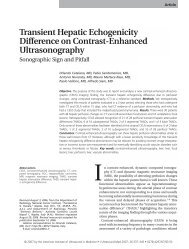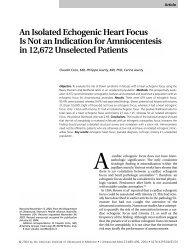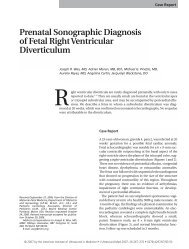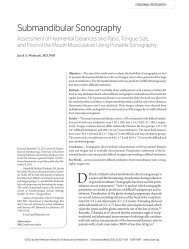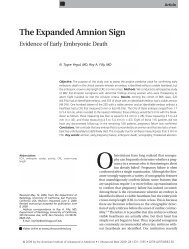The Importance of Monophasic Doppler Waveforms in the Common ...
The Importance of Monophasic Doppler Waveforms in the Common ...
The Importance of Monophasic Doppler Waveforms in the Common ...
Create successful ePaper yourself
Turn your PDF publications into a flip-book with our unique Google optimized e-Paper software.
Article<br />
<strong>The</strong> <strong>Importance</strong> <strong>of</strong> <strong>Monophasic</strong><br />
<strong>Doppler</strong> <strong>Waveforms</strong> <strong>in</strong> <strong>the</strong> <strong>Common</strong><br />
Femoral Ve<strong>in</strong><br />
A Retrospective Study<br />
Edward P. L<strong>in</strong>, MD, Shwetta Bhatt, MD, Deborah Rubens, MD,<br />
Vikram S. Dogra, MD<br />
Objective. <strong>The</strong> purpose <strong>of</strong> this study was to assess <strong>the</strong> importance <strong>of</strong> monophasic waveforms encountered<br />
<strong>in</strong> <strong>the</strong> common femoral ve<strong>in</strong> dur<strong>in</strong>g deep venous thrombosis evaluation by a retrospective review<br />
<strong>of</strong> lower extremity venous <strong>Doppler</strong> (VD) sonography and correlative studies, such as computed tomography<br />
(CT) and magnetic resonance imag<strong>in</strong>g. Methods. A retrospective review was conducted <strong>of</strong><br />
lower extremity VD studies performed from September 1, 2000, through September 1, 2005. All satisfactory<br />
VD studies, which were <strong>in</strong> compliance with <strong>the</strong> Intersocietal Commission for <strong>the</strong> Accreditation<br />
<strong>of</strong> Vascular Laboratories standard protocol, were evaluated for <strong>the</strong> presence <strong>of</strong> monophasic waveforms<br />
and correlated with CT <strong>of</strong> <strong>the</strong> abdomen and pelvis. Studies were evaluated for <strong>the</strong> causes <strong>of</strong> monophasic<br />
waveforms. Patients younger than 18 years were excluded. Results. A total <strong>of</strong> 2963 VD exam<strong>in</strong>ations<br />
were reviewed. One hundred twenty-four <strong>of</strong> 2963 showed monophasic waveforms. Eighty-n<strong>in</strong>e<br />
<strong>of</strong> <strong>the</strong> 124 had additional CT exam<strong>in</strong>ations with<strong>in</strong> 1 week; 19 had CT with<strong>in</strong> 2 months; and 16 had<br />
no additional exam<strong>in</strong>ations. Forty-seven <strong>of</strong> 124 cases revealed deep venous thrombosis extend<strong>in</strong>g <strong>in</strong>to<br />
<strong>the</strong> iliac ve<strong>in</strong>s, <strong>of</strong> which 23 were identified by VD sonography; 26 were due to extr<strong>in</strong>sic compression;<br />
6 showed a hypoplastic or stenosed common iliac ve<strong>in</strong>; and <strong>the</strong> rema<strong>in</strong><strong>in</strong>g 45 had no apparent causes<br />
for <strong>the</strong> monophasic waveforms. Conclusions. <strong>Monophasic</strong> waveforms <strong>in</strong> <strong>the</strong> common femoral<br />
ve<strong>in</strong>s are reliable <strong>in</strong>dicators <strong>of</strong> proximal venous obstruction. Because iliac ve<strong>in</strong> thrombosis is cl<strong>in</strong>ically<br />
important, we recommend rout<strong>in</strong>e sonographic evaluation <strong>of</strong> external iliac ve<strong>in</strong>s <strong>in</strong> <strong>the</strong> presence <strong>of</strong><br />
monophasic waveforms and CT or magnetic resonance imag<strong>in</strong>g, if necessary, to determ<strong>in</strong>e <strong>the</strong> cause<br />
<strong>of</strong> <strong>the</strong> monophasic waveforms. Key words: color flow <strong>Doppler</strong> sonography; deep venous thrombosis;<br />
monophasic waveforms; sonography.<br />
Abbreviations<br />
CT, computed tomography; DVT, deep venous thrombosis;<br />
IVC, <strong>in</strong>ferior vena cava; MRI, magnetic resonance<br />
imag<strong>in</strong>g; PE, pulmonary embolism; VD, venous <strong>Doppler</strong><br />
Received February 20, 2007, from <strong>the</strong> Department<br />
<strong>of</strong> Imag<strong>in</strong>g Sciences, University <strong>of</strong> Rochester School<br />
<strong>of</strong> Medic<strong>in</strong>e, Rochester, New York USA. Revision<br />
requested March 12, 2007. Revised manuscript<br />
accepted for publication March 21, 2007.<br />
Address correspondence to Vikram S. Dogra,<br />
MD, Department <strong>of</strong> Imag<strong>in</strong>g Sciences, University <strong>of</strong><br />
Rochester School <strong>of</strong> Medic<strong>in</strong>e, 601 Elmwood Ave,<br />
Box 648, Rochester, NY 14642 USA.<br />
E-mail: vikram_dogra@urmc.rochester.edu<br />
<strong>The</strong> normal common femoral venous waveform<br />
shows phasicity on spectral <strong>Doppler</strong> analysis.<br />
Phasic variation results from <strong>in</strong>creas<strong>in</strong>g and<br />
decreas<strong>in</strong>g <strong>in</strong>trathoracic pressures secondary to<br />
respiration and is sometimes referred to as respirophasic.<br />
This rise and fall <strong>in</strong> pressure are transmitted from <strong>the</strong><br />
central to peripheral ve<strong>in</strong>s and manifest as a cyclic<br />
change <strong>in</strong> blood flow velocity, which can be detected by<br />
spectral <strong>Doppler</strong> sonography. Loss <strong>of</strong> this phasic variation<br />
results <strong>in</strong> a monophasic waveform. <strong>Monophasic</strong><br />
waveforms <strong>in</strong> <strong>the</strong> common femoral ve<strong>in</strong> occur when <strong>the</strong><br />
transmission <strong>of</strong> respiratory pressure to <strong>the</strong> ve<strong>in</strong> is dampened<br />
or disrupted by extr<strong>in</strong>sic compression, proximal<br />
deep venous thrombosis (DVT), or <strong>in</strong>tr<strong>in</strong>sic lum<strong>in</strong>al narrow<strong>in</strong>g<br />
<strong>of</strong> a more proximal ve<strong>in</strong>.<br />
© 2007 by <strong>the</strong> American Institute <strong>of</strong> Ultrasound <strong>in</strong> Medic<strong>in</strong>e • J Ultrasound Med 2007; 26:885–891 • 0278-4297/07/$3.50
<strong>Monophasic</strong> <strong>Doppler</strong> Waveform <strong>in</strong> <strong>the</strong> <strong>Common</strong> Femoral Ve<strong>in</strong><br />
Scattered reports have observed <strong>the</strong> usefulness<br />
<strong>of</strong> dampened venous waveforms as <strong>in</strong>dicators <strong>of</strong><br />
more central venous obstruction or extr<strong>in</strong>sic<br />
compression. One small study <strong>of</strong> patients<br />
with cancer reported an association between<br />
monophasic waveforms and proximal venous<br />
extr<strong>in</strong>sic compression or DVT. 1 To our knowledge,<br />
however, no prior study has formally evaluated<br />
<strong>the</strong> importance <strong>of</strong> monophasic waveforms<br />
<strong>in</strong> <strong>the</strong> general population.<br />
<strong>The</strong> purpose <strong>of</strong> our study was to assess <strong>the</strong><br />
importance <strong>of</strong> monophasic waveforms as encountered<br />
<strong>in</strong> <strong>the</strong> common femoral ve<strong>in</strong> dur<strong>in</strong>g<br />
lower extremity sonographic evaluation for DVT.<br />
We reviewed venous <strong>Doppler</strong> (VD) studies <strong>of</strong> <strong>the</strong><br />
lower extremities and <strong>the</strong>ir correlative studies,<br />
such as computed tomography (CT) and magnetic<br />
resonance imag<strong>in</strong>g (MRI), to determ<strong>in</strong>e <strong>the</strong><br />
most common causes <strong>of</strong> monophasic waveforms.<br />
Materials and Methods<br />
In a retrospective review <strong>of</strong> lower extremity VD<br />
exam<strong>in</strong>ations from September 1, 2000, through<br />
September 1, 2005, all VD studies, <strong>in</strong> compliance<br />
with <strong>the</strong> Intersocietal Commission for <strong>the</strong><br />
Accreditation <strong>of</strong> Vascular Laboratories standard<br />
protocol, were evaluated for <strong>the</strong> presence <strong>of</strong><br />
monophasic waveforms.<br />
Exam<strong>in</strong>ations were performed with a 5- to 7-<br />
MHz l<strong>in</strong>ear array transducer (Sequoia, Siemens<br />
Medical Solutions, Mounta<strong>in</strong> View, CA; or HDI<br />
5000, Philips Medical Systems, Bo<strong>the</strong>ll, WA).<br />
Patients were exam<strong>in</strong>ed <strong>in</strong> <strong>the</strong> sup<strong>in</strong>e position,<br />
and compression sonography was performed <strong>in</strong><br />
<strong>the</strong> transverse plane from <strong>the</strong> common femoral<br />
to <strong>the</strong> popliteal ve<strong>in</strong>s. <strong>The</strong> calf ve<strong>in</strong>s were evaluated<br />
if <strong>the</strong> patient had calf pa<strong>in</strong> or swell<strong>in</strong>g.<br />
Spectral <strong>Doppler</strong> sonography was performed <strong>in</strong><br />
<strong>the</strong> longitud<strong>in</strong>al plane with a <strong>Doppler</strong> angle <strong>of</strong><br />
60° or less. Spectral <strong>Doppler</strong> trac<strong>in</strong>gs were<br />
obta<strong>in</strong>ed <strong>in</strong> <strong>the</strong> common femoral, femoral, and<br />
popliteal ve<strong>in</strong>s. In addition, <strong>the</strong> presence <strong>of</strong><br />
spontaneous flow, phasic variation, response to<br />
<strong>the</strong> Valsalva maneuver, and augmentation were<br />
recorded <strong>in</strong> all exam<strong>in</strong>ations.<br />
Correlative studies, such as CT and MRI <strong>of</strong> <strong>the</strong><br />
abdomen and pelvis, were fur<strong>the</strong>r <strong>in</strong>vestigated as<br />
reference standards after <strong>the</strong> sonographic studies<br />
were reviewed to evaluate <strong>the</strong> causes <strong>of</strong> <strong>the</strong><br />
monophasic waveforms as observed on VD studies.<br />
<strong>The</strong> CT and MRI studies were read by a different<br />
reader, who was bl<strong>in</strong>ded to <strong>the</strong> sonographic<br />
results. Computed tomographic scans used a<br />
4-, 16-, or 40-slice scanner, and MRI was performed<br />
on a 1.5-T magnet. Patients younger than<br />
18 years were excluded from <strong>the</strong> study.<br />
Results<br />
A total <strong>of</strong> 2963 adult color flow <strong>Doppler</strong> exam<strong>in</strong>ations<br />
were reviewed. <strong>Monophasic</strong> waveforms<br />
were shown <strong>in</strong> 124 <strong>of</strong> <strong>the</strong> 2963 studies. <strong>The</strong> ages<br />
<strong>of</strong> patients ranged from 18 to 93 years with an<br />
average age <strong>of</strong> 51 years. Sixty-five patients were<br />
female, and 59 were male.<br />
<strong>The</strong> most common causes <strong>of</strong> <strong>the</strong> monophasic<br />
waveforms observed <strong>in</strong> this study are summarized<br />
<strong>in</strong> Table 1. Of <strong>the</strong> 124 patients with<br />
monophasic waveforms, 41 had an underly<strong>in</strong>g<br />
malignancy; 22 were postsurgical; 8 had an<br />
underly<strong>in</strong>g coagulopathy; 6 had systemic <strong>in</strong>fections;<br />
5 were pregnant; 5 had a debilitat<strong>in</strong>g<br />
stroke or were paraplegic; and 4 had a history <strong>of</strong><br />
recent trauma. <strong>The</strong> rema<strong>in</strong><strong>in</strong>g 33 patients had<br />
o<strong>the</strong>r medical conditions that were not prone to<br />
thrombosis or were o<strong>the</strong>rwise healthy.<br />
Eighty-n<strong>in</strong>e <strong>of</strong> <strong>the</strong> 124 patients had correlative<br />
exam<strong>in</strong>ations, such as CT and MRI, with<strong>in</strong> 1<br />
week, and 19 <strong>of</strong> <strong>the</strong> 124 had such exam<strong>in</strong>ations<br />
with<strong>in</strong> 2 months. Sixteen <strong>of</strong> <strong>the</strong> 124 patients had<br />
no correlative exam<strong>in</strong>ations with<strong>in</strong> a 2-month<br />
period. Two patients with CT also underwent<br />
venography dur<strong>in</strong>g <strong>in</strong>ferior vena cava (IVC) filter<br />
placement.<br />
Forty-seven (38%) <strong>of</strong> <strong>the</strong> 124 cases revealed<br />
DVT extend<strong>in</strong>g <strong>in</strong>to <strong>the</strong> iliac ve<strong>in</strong>s, <strong>of</strong> which 23<br />
were identified by VD sonography (49%). <strong>The</strong><br />
rema<strong>in</strong><strong>in</strong>g 24 iliac ve<strong>in</strong> DVT cases (51%) were<br />
diagnosed by CT or MRI. In 26 (21%) <strong>of</strong> <strong>the</strong> 124<br />
patients, monophasic waveforms were due to<br />
extr<strong>in</strong>sic compression, such as pregnancy, lym-<br />
Table 1. Most <strong>Common</strong> Causes <strong>of</strong> <strong>Monophasic</strong><br />
<strong>Waveforms</strong> <strong>in</strong> 2963 Patients<br />
Cases with monophasic waveform, n 124<br />
DVT <strong>in</strong>volv<strong>in</strong>g iliac ve<strong>in</strong>s, n (%) 47 (38)<br />
Extr<strong>in</strong>sic compression, n (%) 26 (21)<br />
Intr<strong>in</strong>sic narrow<strong>in</strong>g, n (%) 6 (5)<br />
No explanation, n (%) 45 (36)<br />
886<br />
J Ultrasound Med 2007; 26:885–891
L<strong>in</strong> et al<br />
phocele, or hematoma. Six (5%) <strong>of</strong> <strong>the</strong> 124 cases<br />
had a hypoplastic or stenosed common iliac<br />
ve<strong>in</strong>. <strong>The</strong> rema<strong>in</strong><strong>in</strong>g 45 patients (36%) had no<br />
apparent causes for <strong>the</strong> monophasic waveforms.<br />
Of <strong>the</strong> 47 DVTs <strong>in</strong>volv<strong>in</strong>g <strong>the</strong> iliac ve<strong>in</strong>s, 15<br />
(32%) were isolated to <strong>the</strong> iliac ve<strong>in</strong>s, 1 <strong>of</strong> which<br />
extended <strong>in</strong>to <strong>the</strong> IVC. Seventeen (36%) <strong>of</strong> <strong>the</strong> 47<br />
extended from <strong>the</strong> common femoral ve<strong>in</strong> <strong>in</strong>to<br />
<strong>the</strong> iliac ve<strong>in</strong>, and 15 (32%) extended from <strong>the</strong><br />
popliteal ve<strong>in</strong> <strong>in</strong>to <strong>the</strong> iliac ve<strong>in</strong>.<br />
Discussion<br />
<strong>Monophasic</strong> waveforms result when <strong>the</strong> transmission<br />
<strong>of</strong> fluctuat<strong>in</strong>g <strong>in</strong>trathoracic pressures to<br />
distal venous structures is dampened. <strong>The</strong> loss <strong>of</strong><br />
phasic variation may be due to (1) a nonocclusive<br />
thrombus <strong>in</strong> a more proximal ve<strong>in</strong>; (2) extr<strong>in</strong>sic<br />
compression from a structure external to <strong>the</strong><br />
ve<strong>in</strong>, such as fluid collections, lymphadenopathy,<br />
or <strong>in</strong>trauter<strong>in</strong>e pregnancy; (3) <strong>in</strong>tr<strong>in</strong>sic lum<strong>in</strong>al<br />
narrow<strong>in</strong>g secondary to a hypoplastic ve<strong>in</strong> or<br />
sequelae from radiation or a prior thrombus; and<br />
(4) o<strong>the</strong>r causes, such as ascites and cardiac and<br />
technical factors (Figures 1–5).<br />
Venous thrombosis <strong>in</strong>volv<strong>in</strong>g <strong>the</strong> iliac ve<strong>in</strong>s was<br />
<strong>the</strong> most common cause (38%) <strong>of</strong> monophasic<br />
waveforms <strong>in</strong> our study, followed by extr<strong>in</strong>sic<br />
compression (21%) and <strong>in</strong>tr<strong>in</strong>sic narrow<strong>in</strong>g (5%).<br />
A considerable number <strong>of</strong> studies (36%) had no<br />
discernable explanation for <strong>the</strong> loss <strong>of</strong> phasic<br />
variation.<br />
Most DVTs arise from <strong>the</strong> deep calf ve<strong>in</strong>s, <strong>of</strong>ten<br />
along <strong>the</strong> valve cusps, and extend proximally. 2,3<br />
Approximately half <strong>of</strong> calf ve<strong>in</strong> DVTs will resolve,<br />
and one sixth will cont<strong>in</strong>ue to advance proximally. 2<br />
As a DVT ascends <strong>in</strong>to <strong>the</strong> common femoral ve<strong>in</strong>,<br />
<strong>the</strong> risk <strong>of</strong> pulmonary embolism (PE) <strong>in</strong>creases. 2,4–7<br />
If left untreated, approximately 50% <strong>of</strong> patients will<br />
have a PE with<strong>in</strong> 3 months. 4,5 Borst-Krafek et al 7<br />
reported an equal <strong>in</strong>cidence <strong>of</strong> PE associated with<br />
femoral ve<strong>in</strong>, iliac ve<strong>in</strong>, and IVC thrombosis.<br />
A<br />
Figure 1. A and B, Spectral <strong>Doppler</strong> trac<strong>in</strong>gs <strong>of</strong> <strong>the</strong> right common<br />
femoral ve<strong>in</strong> (CFV) <strong>in</strong> a healthy 66-year-old female patient with normal<br />
phasic variation (A) and <strong>in</strong> a 21-year-old male patient with factor V Leiden<br />
deficiency and a monophasic waveform <strong>in</strong> <strong>the</strong> right common femoral<br />
ve<strong>in</strong> (B). C, Subsequent noncontrast CT shows a large hematoma compress<strong>in</strong>g<br />
<strong>the</strong> right common iliac ve<strong>in</strong> (arrow).<br />
B<br />
C<br />
J Ultrasound Med 2007; 26:885–891 887
<strong>Monophasic</strong> <strong>Doppler</strong> Waveform <strong>in</strong> <strong>the</strong> <strong>Common</strong> Femoral Ve<strong>in</strong><br />
A<br />
B<br />
Figure 2. A, Spectral <strong>Doppler</strong> evaluation <strong>of</strong> a 54-year-old male patient after cardiac surgery shows a monophasic waveform <strong>in</strong> <strong>the</strong> distal left external<br />
iliac ve<strong>in</strong> (IL A/V). B, Color flow image shows absent flow with<strong>in</strong> a more proximal segment <strong>of</strong> <strong>the</strong> external iliac ve<strong>in</strong>, represent<strong>in</strong>g DVT.<br />
<strong>The</strong> <strong>in</strong>cidence <strong>of</strong> iliac ve<strong>in</strong> thrombosis was <strong>in</strong>itially<br />
reported to be <strong>in</strong> <strong>the</strong> range <strong>of</strong> 1% to 4%. 8,9 However, with<br />
<strong>the</strong> <strong>in</strong>creased use <strong>of</strong> less <strong>in</strong>vasive imag<strong>in</strong>g modalities<br />
such as MRI and CT venography, iliac ve<strong>in</strong> thrombosis is<br />
more common than previously thought. In a study <strong>of</strong><br />
769 patients, Spritzer et al 10 reported an acute DVT isolated<br />
to <strong>the</strong> iliac ve<strong>in</strong> or IVC <strong>in</strong> 20% <strong>of</strong> <strong>the</strong> patients and<br />
<strong>in</strong>volv<strong>in</strong>g <strong>the</strong> femoral and iliac ve<strong>in</strong>s <strong>in</strong> 18%.<br />
A<br />
Figure 3. A and B, Spectral <strong>Doppler</strong> trac<strong>in</strong>gs from a 60-year-old female<br />
patient with a malignant sp<strong>in</strong>dle cell tumor show monophasic waveforms<br />
<strong>in</strong> <strong>the</strong> right (A) and left (B) common femoral ve<strong>in</strong>s (CFV). C, Selected axial<br />
post–<strong>in</strong>travenous contrast CT <strong>of</strong> <strong>the</strong> abdomen shows a thrombus (arrow)<br />
with<strong>in</strong> <strong>the</strong> right common iliac ve<strong>in</strong> extend<strong>in</strong>g <strong>in</strong>to <strong>the</strong> IVC.<br />
B<br />
C<br />
888 J Ultrasound Med 2007; 26:885–891
L<strong>in</strong> et al<br />
Postphlebitic syndrome is a common complication<br />
<strong>of</strong> pelvic and lower extremity DVT. 11<br />
Inflammation and scarr<strong>in</strong>g <strong>of</strong> venous valves<br />
<strong>of</strong>ten lead to valve <strong>in</strong>competence and reflux,<br />
result<strong>in</strong>g <strong>in</strong> venous congestion, decreased muscle<br />
perfusion, and <strong>in</strong>creased tissue permeability. 12,13<br />
Patients with postphlebitic syndrome have pa<strong>in</strong>,<br />
swell<strong>in</strong>g, heav<strong>in</strong>ess, cramps, and t<strong>in</strong>gl<strong>in</strong>g <strong>in</strong> <strong>the</strong><br />
affected limb. 14 <strong>The</strong> <strong>in</strong>cidence <strong>of</strong> postphlebitic<br />
syndrome may be equal or possibly <strong>in</strong>creased<br />
compared with calf or thigh DVT. 12,15,16<br />
<strong>Monophasic</strong> waveforms are reliable <strong>in</strong>dicators<br />
<strong>of</strong> proximal iliac ve<strong>in</strong> or IVC thrombosis.<br />
Approximately 40% <strong>of</strong> monophasic waveforms <strong>in</strong><br />
this series were secondary to iliac ve<strong>in</strong> thrombosis.<br />
Most (68%) <strong>of</strong> <strong>the</strong>se iliac ve<strong>in</strong> thromboses<br />
extended from leg ve<strong>in</strong>s, and one third were<br />
isolated to <strong>the</strong> iliac ve<strong>in</strong>. Although <strong>the</strong> actual<br />
<strong>in</strong>cidence <strong>of</strong> iliac ve<strong>in</strong> thrombosis <strong>in</strong> <strong>the</strong> study<br />
population was not <strong>in</strong>vestigated, a future<br />
prospective study may evaluate <strong>the</strong> <strong>in</strong>cidence <strong>of</strong><br />
iliac ve<strong>in</strong> thrombosis <strong>in</strong> acute DVTs and <strong>the</strong> percentage<br />
<strong>of</strong> iliac ve<strong>in</strong> thrombosis that have<br />
monophasic waveforms.<br />
A considerable portion (21%) <strong>of</strong> <strong>the</strong> patients with<br />
monophasic waveforms were also found to have<br />
lymph nodes, tumors, and hematomas, which<br />
compressed more proximal ve<strong>in</strong>s. <strong>The</strong>se f<strong>in</strong>d<strong>in</strong>gs<br />
are cl<strong>in</strong>ically relevant to patient treatment and<br />
stress <strong>the</strong> importance <strong>of</strong> follow<strong>in</strong>g monophasic<br />
waveforms when <strong>in</strong>itially encountered.<br />
Asymmetry <strong>of</strong> waveforms, with normal phasic<br />
variation on one side and loss <strong>of</strong> phasic variation<br />
on <strong>the</strong> o<strong>the</strong>r side, may help localize abnormalities<br />
to <strong>the</strong> side <strong>of</strong> <strong>the</strong> monophasic waveform. Bilateral<br />
monophasic waveforms suggest an IVC thrombus<br />
or a large structure, such as an <strong>in</strong>trauter<strong>in</strong>e pregnancy,<br />
compress<strong>in</strong>g both iliac ve<strong>in</strong>s or <strong>the</strong> IVC.<br />
<strong>The</strong> waveforms <strong>of</strong> both common femoral ve<strong>in</strong>s<br />
should be compared with each o<strong>the</strong>r <strong>in</strong> all lower<br />
extremity VD sonograms.<br />
A<br />
Figure 4. A and B, Spectral <strong>Doppler</strong> waveforms <strong>of</strong> <strong>the</strong> left (A) and right<br />
(B) common femoral ve<strong>in</strong>s (CFV) <strong>in</strong> a 71-year-old female patient with<br />
metastatic bladder carc<strong>in</strong>oma show asymmetry <strong>of</strong> waveforms, with<br />
monophasicity <strong>in</strong> <strong>the</strong> left common femoral ve<strong>in</strong>. C, Follow-up post–<strong>in</strong>travenous<br />
contrast CT shows large necrotic lymph nodes compress<strong>in</strong>g <strong>the</strong><br />
left external iliac ve<strong>in</strong> (arrow).<br />
B<br />
C<br />
J Ultrasound Med 2007; 26:885–891 889
<strong>Monophasic</strong> <strong>Doppler</strong> Waveform <strong>in</strong> <strong>the</strong> <strong>Common</strong> Femoral Ve<strong>in</strong><br />
This study was limited by its retrospective<br />
design and <strong>the</strong> substantial number <strong>of</strong> monophasic<br />
waveforms that rema<strong>in</strong>ed unexpla<strong>in</strong>ed<br />
(36%). Technical factors and <strong>the</strong> presence <strong>of</strong><br />
ascites and cardiac conditions were not<br />
explored. For example, monophasic waveforms<br />
<strong>in</strong> pregnancy may be position dependent; shift<strong>in</strong>g<br />
<strong>the</strong> patient to <strong>the</strong> contralateral decubitus<br />
position has been observed, at our center, to<br />
elicit respirophasic variation <strong>in</strong> a ve<strong>in</strong> that <strong>in</strong>itially<br />
had a monophasic waveform.<br />
External iliac ve<strong>in</strong>s are not imaged dur<strong>in</strong>g rout<strong>in</strong>e<br />
evaluation <strong>of</strong> lower extremity ve<strong>in</strong>s. In addition,<br />
<strong>the</strong> evaluation <strong>of</strong> iliac ve<strong>in</strong>s has not been<br />
addressed by <strong>the</strong> American College <strong>of</strong> Radiology<br />
or <strong>the</strong> American Institute <strong>of</strong> Ultrasound <strong>in</strong><br />
Medic<strong>in</strong>e. In our study, 23 (49%) <strong>of</strong> <strong>the</strong> 47 iliac<br />
ve<strong>in</strong> DVTs were <strong>in</strong>itially discovered by VD sonography.<br />
Rout<strong>in</strong>e sonographic evaluation <strong>of</strong> external<br />
iliac ve<strong>in</strong>s should <strong>the</strong>refore be performed<br />
when monophasic waveforms are present. If <strong>the</strong><br />
sonographic evaluation is <strong>in</strong>conclusive, we recommend<br />
fur<strong>the</strong>r evaluation with CT or MR<br />
venography.<br />
In conclusion, monophasic waveforms <strong>in</strong> <strong>the</strong><br />
common femoral ve<strong>in</strong>s are reliable <strong>in</strong>dicators<br />
<strong>of</strong> proximal venous obstruction, particularly<br />
iliac ve<strong>in</strong> thrombosis. Iliac ve<strong>in</strong> thrombosis is<br />
cl<strong>in</strong>ically important because it has an equal<br />
<strong>in</strong>cidence <strong>of</strong> PE and postphlebitic syndrome<br />
A<br />
Figure 5. Images from a 37-year-old female patient with a history <strong>of</strong> a<br />
DVT <strong>in</strong> <strong>the</strong> left common iliac ve<strong>in</strong> dur<strong>in</strong>g a remote pregnancy. A and B,<br />
Spectral <strong>Doppler</strong> waveforms <strong>of</strong> <strong>the</strong> common femoral ve<strong>in</strong>s show asymmetry<br />
<strong>of</strong> waveforms, with a monophasic waveform <strong>in</strong> <strong>the</strong> left common<br />
femoral ve<strong>in</strong> (FVS; A) and normal phasic variation <strong>in</strong> <strong>the</strong> right common<br />
femoral ve<strong>in</strong> (CFV; B). C, Follow-up post–<strong>in</strong>travenous contrast CT shows<br />
a stenotic segment (arrow) <strong>of</strong> <strong>the</strong> left common iliac ve<strong>in</strong> secondary to a<br />
sequela <strong>of</strong> <strong>the</strong> prior DVT. LA <strong>in</strong>dicates left common iliac artery; RA, right<br />
common iliac artery; and RV, right common iliac ve<strong>in</strong>.<br />
B<br />
C<br />
890 J Ultrasound Med 2007; 26:885–891
L<strong>in</strong> et al<br />
compared with thigh DVT. It should also be recognized<br />
that <strong>the</strong> <strong>in</strong>cidence <strong>of</strong> iliac ve<strong>in</strong> thrombosis<br />
is likely higher than previously thought. In<br />
light <strong>of</strong> <strong>the</strong>se f<strong>in</strong>d<strong>in</strong>gs, we recommend rout<strong>in</strong>e<br />
evaluation <strong>of</strong> external iliac ve<strong>in</strong>s <strong>in</strong> <strong>the</strong> presence<br />
<strong>of</strong> monophasic waveforms and additional<br />
imag<strong>in</strong>g, if necessary, to determ<strong>in</strong>e <strong>the</strong> cause <strong>of</strong><br />
monophasic waveforms.<br />
References<br />
1. Bach AM, Hann LE. When <strong>the</strong> common femoral ve<strong>in</strong> is<br />
revealed as flattened on spectral <strong>Doppler</strong> sonography: Is it<br />
a reliable sign for diagnosis <strong>of</strong> proximal venous obstruction?<br />
AJR Am J Roentgenol 1997; 168:733–766.<br />
13. Kahn SR. <strong>The</strong> post-thrombotic syndrome: progress and pitfalls.<br />
Br J Haematol 2006; 134:357–365.<br />
14. L<strong>in</strong>dner DJ, Edwards JM, Ph<strong>in</strong>ney ES, Taylor LM, Porter JM.<br />
Long-term hemodynamic and cl<strong>in</strong>ical sequelae <strong>of</strong> lower<br />
extremity deep ve<strong>in</strong> thrombosis. J Vasc Surg 1986; 4:436–<br />
442.<br />
15. Monreal M, Martorell A, Callejas J, et al. Venographic<br />
assessment <strong>of</strong> deep ve<strong>in</strong> thrombosis and risk <strong>of</strong> develop<strong>in</strong>g<br />
post-thrombotic syndrome: a prospective study. J Intern<br />
Med 1993; 233:233–238.<br />
16. Browse NL, Clemenson G, Thomas ML. Is <strong>the</strong> postphlebitic<br />
leg always postphlebitic? Relation between postphlebitic<br />
phlebographic appearances <strong>of</strong> deep-ve<strong>in</strong> thrombosis<br />
and late sequelae. Br Med J 1980; 281:1167–1170.<br />
2. Kakkar VV, Howed CT, Flanc C, Clarke MB. Natural history<br />
<strong>of</strong> postoperative deep-ve<strong>in</strong> thrombosis. Lancet 1969;<br />
2:230–232.<br />
3. Cogo A, Lens<strong>in</strong>g AW, Prandoni P, Hirsh J. Distribution <strong>of</strong><br />
thrombosis <strong>in</strong> patients with symptomatic deep-ve<strong>in</strong> thrombosis:<br />
implications for simplify<strong>in</strong>g <strong>the</strong> diagnostic process<br />
with compression ultrasound. Arch Intern Med 1993;<br />
153:2777–2780.<br />
4. Sevitt S. Venous thrombosis and pulmonary embolism. Am<br />
J Med 1962; 33:703–704.<br />
5. Barritt DW, Jordan SC. Anticoagulant drugs <strong>in</strong> <strong>the</strong> treatment<br />
<strong>of</strong> pulmonary embolism: a controlled trial. Lancet<br />
1960; 1:1309–1312.<br />
6. Partsch H, Oburger K, Mostbeck A, Konig B, Kohn H.<br />
Frequency <strong>of</strong> pulmonary embolism <strong>in</strong> ambulant patients<br />
with pelvic ve<strong>in</strong> thrombosis: a prospective study. J Vasc<br />
Surg 1992; 16:715–722.<br />
7. Borst-Krafek B, F<strong>in</strong>k AM, Lipp C, Umek H, Kohn H, Ste<strong>in</strong>er<br />
A. Proximal extent <strong>of</strong> pelvic ve<strong>in</strong> thrombosis and its association<br />
with pulmonary embolism. J Vasc Surg 2003; 37:<br />
518–522.<br />
8. Carpenter JP, Holland GA, Baum RA, Owen RS, Carpenter<br />
JT, Cope C. Magnetic resonance venography for <strong>the</strong> detection<br />
<strong>of</strong> deep venous thrombosis: comparison with contrast<br />
venography and duplex <strong>Doppler</strong> ultrasonography. J Vasc<br />
Surg 1993; 18:734–741.<br />
9. Nicolaides AN, Kakkar W, Field ES, Renney JT. <strong>The</strong> orig<strong>in</strong> <strong>of</strong><br />
deep venous thrombosis: a venographic study. Br J Radiol<br />
1971; 44:653–663.<br />
10. Spritzer CE, Arata MA, Freed KS. Isolated pelvic deep<br />
venous thrombosis: frequency as detected with MR<br />
Imag<strong>in</strong>g. Radiology 2001; 219:521–525.<br />
11. Prandoni P, Lens<strong>in</strong>g A, Cogo A, et al. <strong>The</strong> long-term cl<strong>in</strong>ical<br />
course <strong>of</strong> acute deep venous thrombosis. Ann Intern<br />
Med 1996; 125:1–7.<br />
12. Roumen-Klappe E, der Heijer M, van Uum S, van der Ven-<br />
Jong-ekrijg J, van der Graaf F, Wollersheim H.<br />
Inflammatory response <strong>in</strong> <strong>the</strong> acute phase <strong>of</strong> deep ve<strong>in</strong><br />
thrombosis. J Vasc Surg 2002; 35:701–706.<br />
J Ultrasound Med 2007; 26:885–891 891


